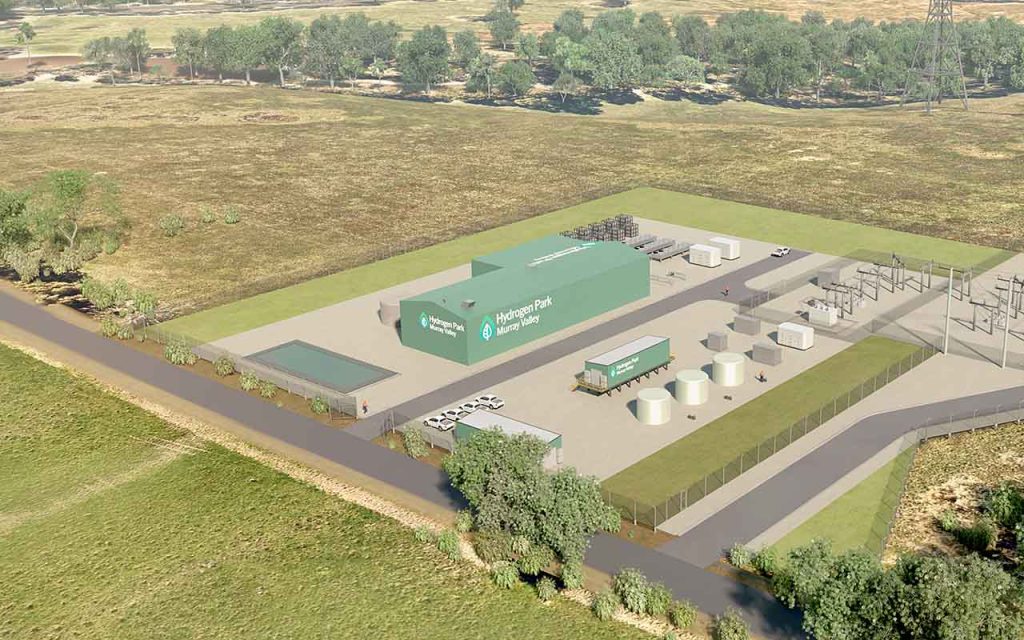AGIG’s Hydrogen Park Murray Valley development in Wodonga will raise Australia’s renewable hydrogen production to a new level.

The 10MW Hydrogen Park Murray Valley development will initially blend hydrogen into the local natural gas network (Artist render)
A renewable hydrogen project, promising production on a scale so far not achieved in Australia, has passed an important milestone.
The 10MW Hydrogen Park Murray Valley development in Wodonga in north-eastern Victoria has now reached financial close.
As a result, ARENA is committing $36.1 million to what, when completed, will be the largest renewable hydrogen facility in the east of Australia.
The funding builds on ARENA’s leading role in renewable hydrogen which has seen more than $255 million committed since 2017.
The May Federal Budget also gave ARENA a key role in designing and supporting the $2 billion Hydrogen Headstart initiative. The program aims to position Australia as a renewable hydrogen early mover and global leader.
How will the renewable hydrogen be used?
ARENA initially awarded funding to Australian Gas Networks (AGIG) for its Wodonga development in May 2021. AGIG was a successful applicant to ARENA’s Renewable Hydrogen Deployment Funding Round.
This is the second project from that round to achieve financial close.
Another recipient, Engie Renewables Australia, achieved financial close in September 2021. Engie’s Yuri Project will use renewable electricity to produce hydrogen for renewable ammonia production. The ammonia will in turn feed to manufacture fertiliser. and supply it to the adjacent Yara Pilbara Fertiliser facility.
AGIG’s facility will initially supply renewable hydrogen for injection into the local natural gas distribution network. Up to 10 per cent hydrogen will be blended with natural gas to reduce local carbon emissions.
Network owner Australian Gas Networks, part of AGIG, estimates there are more than 40,000 gas connections, serving around 85,000 people in Victoria and across the border in NSW.
The 10 per cent hydrogen blend will cut approximately 4000 tonnes of CO2 each year.
Growing Australia’s hydrogen industry
ARENA CEO Darren Miller said the project is exciting because it will reduce local emissions from day one of operation.
“It’s essential to scaling up Australia’s renewable hydrogen industry that we get these first-generation projects up and running,” he said.
“The lessons we learn here will help inform our hydrogen industry as it grows from its early stages to a pillar of the net zero economy.”
Mr Miller added that the project would have the potential to supply additional markets as they move towards net zero.
“Reliable supply of renewable hydrogen in places like Wodonga is going to be needed as hydrogen plays as growing role in road freight,” he said.
Additional financial backing
The Victorian Government is supporting the project with $12.315 million through the Department of Energy, Environment and Climate Action (DEECA). The Clean Energy Finance Corporation (CEFC) is providing additional financial backing.
Mars Petcare Australia will purchase Renewable Gas Guarantee of Origin certificates , generated by the project. Federal government accreditation program GreenPower will match the the energy use of Mars’ local pet food factory to the renewable hydrogen added to the local gas network.
AGIG CEO Craig de Laine said that AGIG is proud to work with both the Australian and Victorian Governments on this landmark project.
“The strong support received from both the Australian and Victorian Governments demonstrates the importance of renewable hydrogen to decarbonising energy across Australia. We thank all our project partners and key stakeholders, including the Albury-Wodonga community for their contribution to the project to date.”
Construction on the project is due to start in 2023, with the site operational by 2025.
